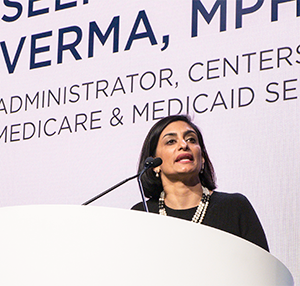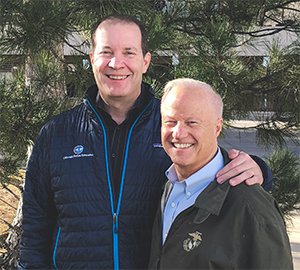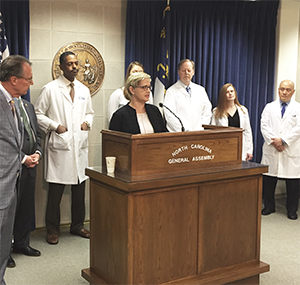Federal Advocacy: Building New Relationships to Advance Patient Care

Seema Verma, MPH delivered the keynote address at AAO 2017, presenting a frontline account of federal efforts to improve the U.S. health care system. Ms. Verma is the current CMS administrator.
The past year’s evolving health care landscape provided significant challenges — but also opportunities — as the Academy advocated on behalf of ophthalmology and our patients. Our successes resulted from carefully cultivated relationships with regulators and lawmakers, coupled with exemplary ophthalmologist-led advocacy.
Preserving the Physician-Patient Relationship Through Regulatory Relief
In January, the Academy launched an aggressive effort to secure regulatory relief for all physicians. Our focus remains on reducing administrative burdens and penalties that prevent physicians from spending more time with patients.
So far, Academy-led coalition efforts have gained some much-needed relief from penalties that will affect physicians in 2018. We also made gains to unburden federal quality reporting.
Ensuring Physicians’ Success in Medicare’s New Physician Payment System
In 2017, our profession was among the most prepared in medicine for the first year of the Quality Payment Program, Medicare’s value-based payment system for physicians. This includes the Merit-Based Incentive Payment System, the fee-for-service pathway through which most ophthalmologists participate.
The Academy took steps to help all ophthalmologists avoid all 2019 penalties for this year’s performance. We also helped win significant relief for small practices participating in the program in 2018, while keeping passing thresholds low for other practitioners.
Protecting Patients’ Timely Access to Critical Compounded Treatments
Thanks in part to our ongoing advocacy efforts, the Food and Drug Administration released a new draft guidance that provides ophthalmology with a pathway to continued access to repackaged Avastin. Also, legislation has been introduced by the Academy’s congressional allies to allow traditional compounding pharmacies to retain the ability to compound for office use in states that allow for office use.
Advocating to Delay Proposed Changes to the Contact Lens Rule
Following more than two years of Academy advocacy, the Federal Trade Commission announced in December that it will delay issuing final guidance on its update to the Contact Lens Rule. Our efforts were rooted in preventing the agency from forcing prescribers to obtain signed patient acknowledgement forms that confirm receipt of their contact lens prescription.
Positioning Subspecialists for Success Via New Taxonomy Codes
The Academy capped a successful three-year effort to enable subspecialists’ success in federal programs and possibly other insurance company data using taxonomy codes. The National Uniform Claim Committee accepted seven Academy-developed designations that we hope will also be adopted beyond Medicare by private insurers.
OPHTHPAC: Strengthening Ophthalmology’s Federal Advocacy

Brian Joondeph, MD, MPS, FACS, left, and Rep. Mike Coffman, R-Colo., met recently for lunch. This conversation, made possible in part by OPHTHPAC, enabled Dr. Joondeph to expound on the Academy’s regulatory relief and compounding efforts, for which Rep. Coffman offered his support.
Ophthalmology’s federal advocacy in 2017 was strengthened by the access provided by the Academy’s OPHTHPAC® fund. OPHTHPAC uses the investments of U.S. ophthalmologists to ensure our profession has the necessary relationships to enact change in Washington, D.C.
OPHTHPAC is a non-partisan political action committee that contributes to both Democrats and Republicans, because legislation is more easily passed when supported by both political parties. When legislative fights emerged in 2017, OPHTHPAC helped ensure we had allies from both sides of the aisle on our side in Washington, D.C.
In 2017, the OPHTHPAC fund raised $702,910 from 1,625 Academy members. This means that:
- We’ve reached 35 percent of the Academy’s $2 million fundraising goal for 2017–2018.
- Through 9 percent participation by the Academy’s U.S. members, fewer ophthalmologists are taking on more of the burden of strengthening our profession’s PAC and, thus, our ability to effectively advocate on the federal level.
Our profession must be ready for the coming federal battles against well-fortified opponents. For example, optometrists signaled federal aspirations by opening a 3-to-1 cash-on-hand margin for their PAC, compared to ours. And primary care is using its PAC to generate strong support for rebalancing Medicare in favor of gatekeeper physicians.
Every ophthalmologist has an obligation to take the necessary steps to protect our profession. Make your investment today to keep OPHTHPAC strong and amplify our voice on Capitol Hill.
Support OPHTHPAC
Nearly 90 percent of Congress is up for reelection in 2018. Because of this, OPHTHPAC’s election-year participation is vital to our profession to ensure that our congressional champions remain in office, while building and sustaining relationships with Congress’ new faces.
OPHTHPAC took the following steps in 2017 to prepare for this coming election year:
- Tracking congressional races nationwide;
- Hosting fundraisers for key members of Congress to help educate them on specialty medicine’s issues;
- Holding meet-and-greets with new federal candidates; and
- Requesting information from a dozen declared and potential candidates.
Help strengthen the OPHTHPAC fund to ensure we have a strong presence in 2018’s many congressional races.
|
State Government Affairs: Advancing Patient-Centered Policies, One State at a Time

2017 Academy President Cynthia Ann Bradford, MD, visited North Carolina lawmakers to share ophthalmologists' perspectives on a patient-care legislative proposal.
State legislatures are increasingly asked to consider proposals that have a significant effect on ophthalmology’s patients and how we provide care. The Academy partners with state societies nationwide to ensure that only the most appropriate legislation becomes law.
In 2017, the Academy found state-based success in the following areas:
Legislation That Promotes Patient-Centered Care
State legislatures determine how patient care is delivered across the country and by whom. In 2017, the Academy partnered effectively with state ophthalmology and medical societies in several key states to help shape such legislative proposals. In each effort, we advocate for the highest quality of ophthalmic care for our patients.
The Academy is determined to ensure that patients have access to the proper treatment from qualified health care practitioners. This means preserving ophthalmologists’ role as the primary provider of eye care and the leader of the eye-care team.
Access to Sight-Saving Prescription Eyedrops
More than 50 percent of the U.S. now offers early prescription-eyedrop refills, due to an on-going Academy initiative to provide patients with access to self-administered prescription eyedrops, which often involve a reasonable amount of waste.
Minnesota is the latest state to allow early refills of sight-saving prescription eyedrops. With 26 states on board, the Academy continues to support ophthalmologists who use this issue as an opportunity to build a meaningful relationship with their state lawmakers, while advocating for our patients.
Spurring Technological Innovation
The Academy believes physicians should have the right to evaluate new technologies to determine what is appropriate for our patients. This stance was bolstered by an Academy-endorsed effort in Virginia to authorize telemedicine for seeing patients and issuing prescriptions for eyeglasses and contact lenses. It also paves the way for online refraction.
The Virginia Society of Eye Physicians and Surgeons supported the measure, which aligns with the Academy’s policy statement on use of innovative technologies in diagnosing eye diseases and conditions.